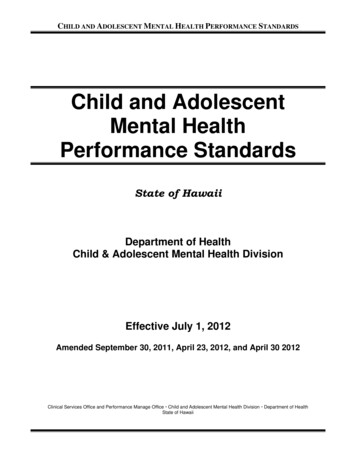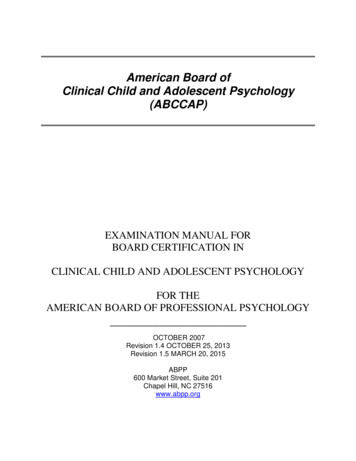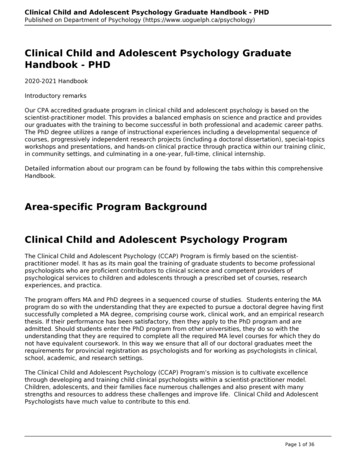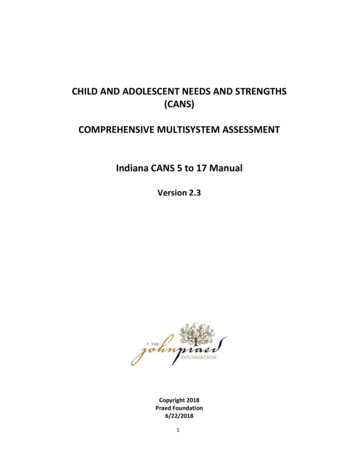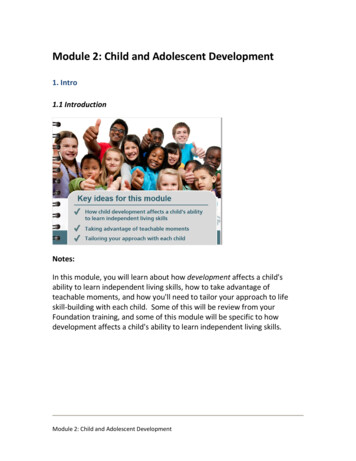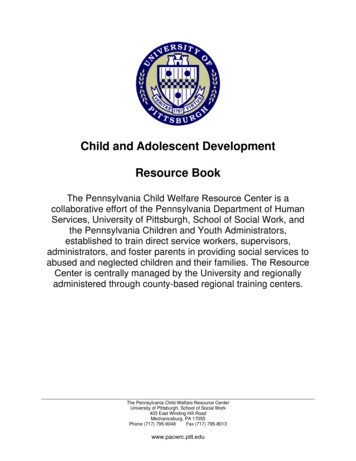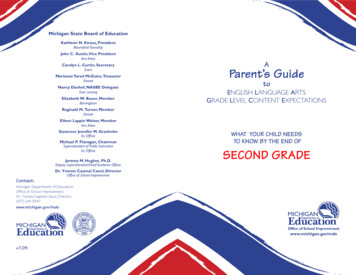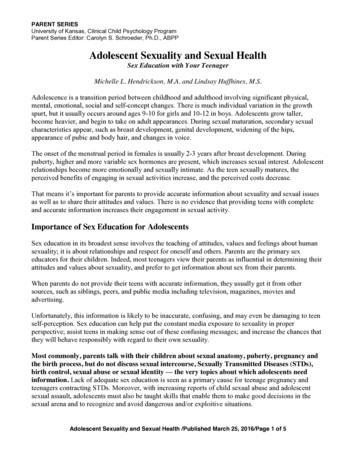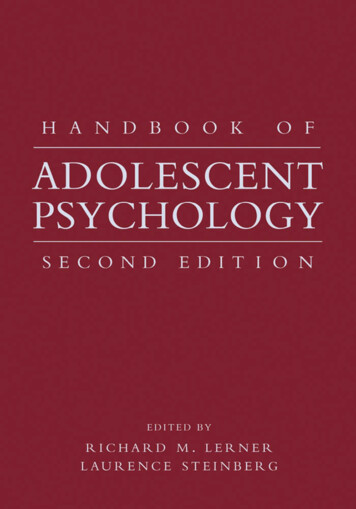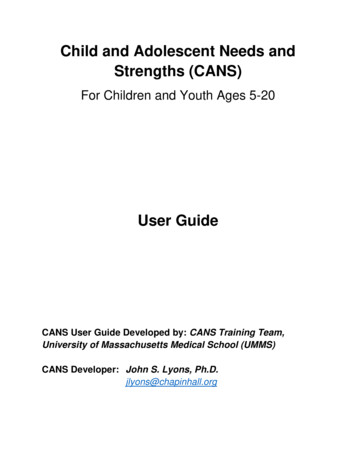
Transcription
Child and Adolescent Needs andStrengths (CANS)For Children and Youth Ages 5-20User GuideCANS User Guide Developed by: CANS Training Team,University of Massachusetts Medical School (UMMS)CANS Developer: John S. Lyons, Ph.D.jlyons@chapinhall.org
Table of ContentsChild and Adolescent Needs and Strengths (CANS) . 1Introduction to User Guide . 3LIFE DOMAIN FUNCTIONING . 3CHILD/ADOLESCENT BEHAVIORAL/EMOTIONAL NEEDS . 11CHILD/ADOLESCENT RISK BEHAVIORS . 17CULTURAL CONSIDERATIONS . 24TRANSITION TO ADULTHOOD . 29CHILD/ADOLESCENT STRENGTHS . 33CAREGIVER NEEDS . 38
Introduction to User GuideThe CANS User Guide was developed with the Certified Assessor in mind, for ongoing use inclinical practice.The CANS User Guide replaces previous versions, including the CANS Glossary and the CANSUser Manual, and reflects knowledge obtained by the UMMS CANS Training team in preparingtens of thousands of clinicians in Massachusetts to become certified CANS users. The CANSUser Guide contains useful information for rating each item in the CANS. Each item contains theitem definition and the definition for each rating, as well as supplemental questions that maybe relevant to clinical practice. In 2015, the CANS User Guide was revised in order to updateitem definitions and ensure that the operational definitions for each rating are clear andconcise and help the clinician to rate each item as accurately and consistently as possible.Overall, the CANS User Guide is intended is to provide clinicians with additional guidance torate items across multiple domains, in a single document.LIFE DOMAIN FUNCTIONINGLife domains are the different areas of social interaction found in the lives of thechild/adolescent. This domain rates how they are functioning in the individual, family, peer,school, and community realms. Although the child’s social interactions may be affected by thefamily interactions, this domain rates struggles the child/adolescent is experiencing. Thissection is rated using the Needs scale.For Life Domain Functioning, the following action levels are used:RatingDefinition0Indicates a life domain in which there is no evidence of a need.1Indicates a life domain in which there is a relevant history or suspicion of a needwhere watchful waitingi is recommended.2Indicates a life domain in which the child/adolescent is having problems and/oraction is required to improve functioning.3Indicates a life domain in which the child/adolescent is having severe problemsand/or immediate action is required to improve functioning.
FAMILY FUNCTIONINGThis item rates the child/adolescent’s relationships with those who are in his/her family. It isrecommended that the definition of family should come from the child/adolescent’sperspective (e.g., who the child/adolescent describes as his/her family). If you do not know thisinformation, then we recommend a definition of family that includes biological relatives andtheir significant others with whom the child/adolescent comes into contact.Questions to Consider Does the child/adolescent haveconflicts with the family? Are there problems between thechild and other family members? Has there ever been any violencebetween the child/adolescent andother family members?Further help with Family Functioning?Ratings Anchor Definitions0) No evidence of relationship problemswithin the family.1) Relevant history or suspicion ofrelationship problems with familymembers where watchful waitingi isrecommended.2) Child/adolescent has relationshipproblems with family members and/oraction is required.3) Child/adolescent has severe relationshipproblems with family members and/orimmediate action is required.
SOCIAL FUNCTIONINGThis item rates difficulty a child/adolescent may have with relationships outside of the family,and particularly with peers. It includes age-appropriate social behavior, the ability to developand maintain peer relationships, and evidence of adaptive peer relationships. A child withnegative or little social engagement may have a need to build social skills.Questions to Consider Does the youth get along withothers? Does the youth know how to makenew friends? Does the youth have any conflictswith peers? Does s/he have unhealthyfriendships? Does the youth have any closefriends? Does s/he tend to change friendsfrequently? Does the youth interactappropriately in groups?Ratings Anchor Definitions0) No evidence of relationship problemsoutside the family.1) Relevant history or suspicion ofchild/adolescent having relationshipproblems outside the family wherewatchful waitingi is recommended.2) Child/adolescent has relationshipproblems outside the family and/oraction is required.3) Child/adolescent has severerelationship problems outside the familyand/or immediate action is required.Further help with Social Functioning?MEDICAL/PHYSICALThis item rates the child/adolescent’s current health status or any physical limitations. Thisitem does not rate depression or other mental health issuesQuestions to Consider Is the child/adolescent generallyhealthy? Does s/he have any medicalproblems or physical limitations? Does the child have any chronicillnesses such as asthma ordiabetes? How much does this interfere withhis/her life?Further help with Medical/Physical?Ratings Anchor Definitions0) No evidence of medical/physical problems.1) Relevant history or suspicion of thechild/adolescent having medical/physicalproblems where watchful waitingi isrecommended.2) Child/adolescent has medical/physicalproblems that require medical intervention.3) Child/adolescent has severe life-threateningillness or physical condition that requiresimmediate medical intervention.
DEVELOPMENTAL DELAYThis item rates only the presence of developmental disabilities. It includes the youth’s ability tounderstand, process, and express language; the youth’s cognitive/intellectual functioning;deficits in social communication and interaction; and repetitive, restrictive patterns ofbehaviors, interests, or activities. It includes Autism Spectrum Disorders. It is important to notethat there is normal variation around the age children/adolescents will achieve specificdevelopmental milestones. Thus, a developmental delay refers to a child/adolescent who isunable to reach a milestone within that range of expected variability.Questions to Consider Does the child/adolescent’s growthand development seem healthy? Has s/he reached appropriatedevelopmental milestones (such aswalking, talking)? Has the child/adolescent beenscreened for any developmentalproblems?Further help with Developmental Delay?Ratings Anchor Definitions0) No evidence of a developmental delay.1) Relevant history or suspicion of thechild/adolescent having adevelopmental delay where watchfulwaitingi is recommended.2) Child/adolescent has a developmentaldelay and/or action is required.3) Child/adolescent has severe, pervasive,or profound developmental delayand/or immediate action is required.
LEARNING DISABILITYThis item rates the limitations that have an impact on academic learning including reading,writing, speaking, spelling, computing, and/or abilities that affect attention, memory,coordination, or social skills. Of note, ratings should not reflect factors that temporarily affect achild/adolescent’s academic performance or ability to learn. For example, grief that has anegative impact on learning should not be rated as a learning disability.Learning disabilities usually require special educational strategies to ensure that thechild/adolescent is in an environment where he or she can learn.Questions to Consider Does s/he have difficulty reading,writing, spelling, reasoning,recalling, and/or organizinginformation? Has the child/adolescent ever beentested for or diagnosed with alearning disability? Are there concerns that thechild/adolescent may have alearning disability?Further help with Learning Disability?Ratings Anchor Definitions0) No evidence of a learning disability.1) Relevant history or suspicion ofchild/adolescent having a learningdisability where watchful waitingi isrecommended.2) Child/adolescent shows evidence of alearning disability and/or action isrequired.3) Child/adolescent has a severe learningdisability and/or immediate action isrequired.SEXUAL BEHAVIORThis item examines whether a youth’s sexual behavior is developmentally appropriate. Sexualorientation and/or gender identity should not be considered in this item but rather underCultural Considerations.Questions to Consider Is the child/adolescent engaging ininappropriate sexual relationships? Does the child/adolescent have anunderstanding of consent? Does he/she have less interest/moreinterest in sex than otherchildren/adolescents his/her age?Further help with Sexual Behavior?Ratings Anchor Definitions0) No evidence of developmentallyinappropriate sexual behavior.1) Relevant history or suspicion of thechild/adolescent engaging indevelopmentally inappropriate sexualbehavior where watchful waitingi isrecommended.2) Child/adolescent engages indevelopmentally inappropriate sexualbehavior and/or action is required.3) Child/adolescent engages in severedevelopmentally inappropriate sexualbehavior and/or immediate action isrequired.
SELF CAREThis rating describes the child/adolescent's ability to perform developmentally appropriateactivities of daily living and hygiene tasks – for example, toileting, feeding, and grooming. Thisitem does not include taking medication, which is rated under the Medical Adherence item.Ratings Anchor DefinitionsQuestions to Consider0) No evidence of self-care problems Is the child/adolescent able to eat,1) Relevant history or suspicion of theshower, dress, and toilet withoutchild/adolescent having self-careassistance?problems where watchful waitingi is Have concerns been expressedrecommended.regarding the child/adolescent’s2) Child/adolescent self-care problems arehygiene?evident and/or action is required.Further help with Self Care?3) Child/adolescent has severe self-careproblems and/or immediate action isrequired.COMMUNITYThis rating describes problems with following rules in the community, for example, in a faithgroup, an afterschool activity, or in stores. Some children struggle when out in the communitywith or without friends. Please note: School is not considered part of the definition ofcommunity in the rating of this item, as school is rated in its own items.Questions to Consider Has the child/youth ever been introuble at an event outside ofschool? Are there concerns about thechild/youth acting safely when s/heis out in the community? Does the child/youth resist going tocommunity activities? Does s/he follow communitynorms/laws? Are there concerns that s/he may beremoved from the community forbreaking the law?Further help with Community?Ratings Anchor Definitions0) No evidence of problems withfunctioning in the community.1) Relevant history or suspicion ofchild/adolescent having problems withcommunity functioning where watchfulwaitingi is recommended.2) Child/adolescent problems withcommunity functioning are evidentand/or action is required.3) Child/adolescent has severe problemsfunctioning in the community and/orimmediate action is required.
SCHOOL ITEMSThe following three items (School Behavior, School Achievement, and School Attendance)address various aspects of school functioning and should be rated independently. In completingratings for School items, children/adolescents should be compared to their relative peer group.For children/adolescents receiving special education services, ratings should take intoconsideration goals and objectives from the Individualized Education Program (IEP).SCHOOL BEHAVIORThis item rates the child/adolescent’s behavioral problems in school, such as disruptions, and israted independently from attendance and achievement. For example, a youth may befrequently absent, but exhibit appropriate behavior when he/she attends school.Questions to ConsiderRatings Anchor Definitions0)No evidence of school behavior How is the child/adolescentbehaving in school?problems. Has he/she had any behavioral1) Relevant history or suspicion ofproblems?child/adolescent having school behavior Has the teacher or other schoolproblems where watching waitingi ispersonnel called therecommended.child/adolescent’s parents to talk2) Child/adolescent school behaviorabout his/her behavior?problems are evident and/or action isFurther help with School Behavior?required.3) Severe child/adolescent school behaviorproblems are evident and/or immediateaction is required.SCHOOL ACHIEVEMENTThis item rates the child/adolescent’s grades or level of academic achievement.Questions to ConsiderRatings Anchor Definitions0) No evidence of school achievement How is the child/adolescent doingproblems.academically in school?1)Relevant history or suspicion of Is s/he having difficulty with anychild/adolescent having problems withsubjects?school achievement where watchful Is s/he at risk of failing any classes?waitingi is recommended.Of being left back?2) Child/adolescent problems with school Has the teacher or other schoolachievement are evident and/or actionpersonnel spoken to theis required.child/adolescent’s parents about3) Severe child/adolescent schoolher/his performance?achievement problems are evident Is the child/adolescent performingon grade level?and/or immediate action is required.Further help with School Achievement?
SCHOOL ATTENDANCEThis item rates issues related to absences, tardiness, and/or truancy.Questions to Consider Has the child/adolescent had anydifficulty with getting to or staying inschool? Has the teacher or other schoolpersonnel called thechild/adolescent’s parents abouthis/her attendance?Further help with School Attendance?Ratings Anchor Definitions0) No evidence of school attendanceproblems.1) Relevant history or suspicion of thechild/adolescent having problems withschool attendance where watchfulwaitingi is recommended.2) Child/adolescent school attendanceproblems are evident and/or action isrequired.3) Severe child/adolescent schoolattendance problems are evidentand/or immediate action is required
CHILD/ADOLESCENT BEHAVIORAL/EMOTIONAL NEEDSFor the Child/Adolescent Behavioral/Emotional Needs domain, the following action levels are used:RatingDefinition0No evidence of a behavioral/emotional need.1Relevant history or suspicion that the child/adolescent has behavioral/emotionalneeds where watchful waitingi is recommended.2Child/adolescent has behavioral/emotional needs and/or action is required.3Child/adolescent has severe behavioral/emotional needs and/or immediate actionis required.PSYCHOSISThe primary symptoms of psychosis include hallucinations (experiencing things others do notexperience), delusions (a false belief or an incorrect inference about reality that is firmly sustaineddespite the fact that nearly everybody thinks the belief is false or proof exists of its inaccuracy), andbizarre behavior, as well as strange or incoherent speech. Psychosis may also be referred to as a thoughtdisorder or perceptual disturbance and includes behaviors and symptoms that may be associated withseveral DSM-5 disorders (e.g., Schizophrenia, Schizoaffective Disorder, Delusional Disorder, BipolarDisorder, Major Depressive Disorder, etc.). Note: To rate as evidence of psychosis, behaviors andsymptoms should not be attributed to substance use or another medical explanation.Questions to Consider Has the child/adolescent ever talkedabout hearing, seeing, or feelingsomething that was not actuallythere? Has the child/adolescent ever donestrange or bizarre things that madeno sense? Does the child/adolescent havestrange beliefs about things? Does child/adolescent have thoughtdisorder or a psychotic condition?Further help with Psychosis?Ratings Anchor Definitions0) No evidence of psychosis.1) Relevant history or suspicion ofchild/adolescent psychosis wherewatchful waitingi is recommended.2) Child/adolescent psychosis is evidentand/or action is required.3) Severe child/adolescent psychosis isevident and/or immediate action isrequired.
HYPERACTIVITY/IMPULSIVITYYouth who have problems with hyperactivity and impulsivity often have difficulty staying focused andpaying attention, difficulty controlling behavior, and/or over-activity (hyperactivity).Questions to Consider Does s/he have trouble payingattention for more than a fewminutes? Is the child/adolescentable to control him/herself? Does the child/adolescent reportfeeling compelled to do somethingdespite negative consequences?Further help with Hyperactive/Impulsivity?Ratings Anchor Definitions0) No evidence ofhyperactivity/impulsivity.1) Relevant history or suspicion ofchild/adolescenthyperactivity/impulsivity wherewatchful waitingi is recommended.2) Child/adolescenthyperactivity/impulsivity is evidentand/or action is required.3) Severe child/adolescenthyperactivity/impulsivity is evidentand/or immediate action is required.DEPRESSIONThis item rates behaviors and symptoms consistent with depression that include irritable,depressed mood, diminished interest in previously enjoyed activities, difficulty sleeping,changes in eating habits or weight, hopelessness, social withdrawal or isolation, and/ordifficulty concentrating. While depression and anxiety often occur together, it is important todifferentiate the symptoms for the purposes of rating CANS.Questions to Consider Does the child/youth have difficultygetting out of bed in the morning? Has s/he withdrawn from normalactivities? Is the child/youth experiencing morethan what you would consider“normal sadness”? Does the child/youth expresshopelessness about his/her future?Further help with Depression?Ratings Anchor Definitions0) No evidence of depression.1) Relevant history or suspicion ofchild/adolescent depression wherewatchful waitingi is recommended.2) Child/adolescent depression is evidentand/or action is required.3) Severe child/adolescent depression isevident and/or immediate action isrequired.ANXIETYThis item rates behaviors and symptoms consistent with anxiety that include excessive worry,panic attacks, somatic complaints, physiological reactivity, fear of meeting new people orembarrassing oneself in social situations, fear of a specific object or situation (phobia), and/or
uncontrollable or repetitive thoughts that are often accompanied by repetitive behaviors. Thisitem rates the presence of behavior consistent with anxiety, not whether the reasons foranxiety are understood. A reason to worry should not be rated here. While depression andanxiety often co-occur together, it is important to look for distinct symptoms for the purpose ofrating CANS.Questions to Consider Does the child/adolescent have anyproblems with fearfulness? Is s/he avoiding normal activities outof fear about them? Does the child/adolescent actfrightened or afraid? Does the child/adolescent worry alot? Does the child/adolescent havepanic attacks?Further help with Anxiety?Ratings Anchor Definitions0) No evidence of anxiety.1) Relevant history or suspicion ofchild/adolescent anxiety wherewatchful waitingi is recommended.2) Child/adolescent anxiety is evidentand/or action is required.3) Severe child/adolescent anxiety isevident and/or immediate action isrequired.OPPOSITIONAL BEHAVIORThis item describes the presence of persistent angry and irritable mood, repeatedargumentative and defiant behavior, and/or vindictiveness. The distinction betweenoppositional behavior and a child being strong willed or emotional is an important one, andshould be considered carefully when rating this item.Questions to Consider Does the child or adolescentdemonstrate vindictiveness towardsothers? How does the child respond toreasonable boundaries andexpectations? Does the child/adolescent argue withadults when they try to get her/him todo something? Does the child or youth get into troubleregularly because of defiant orargumentative behavior?Further help with Oppositional Behavior?Ratings Anchor Definitions0) No evidence of oppositional behavior.1) Relevant history or suspicion ofchild/adolescent oppositional behaviorwhere watchful waitingi is recommended.2) Child/adolescent oppositional behavior isevident and/or action is required.3) Severe child/adolescent oppositionalbehavior is evident and/or immediateaction is required.
CONDUCTThis item is used to describe a youth’s engagement in a willful, repetitive pattern of behaviorthat includes aggression toward people or animals, destruction of property, deceitfulness ortheft, and/or serious violations of society’s rules or laws.Questions to Consider Is the child/adolescent seen asdishonest? How does the child/adolescenthandle telling the truth/lies? Has the child/adolescent been partof any criminal behavior? Has the child/adolescent ever shownviolent or threatening behaviortowards others? Has the child/adolescent evertortured animals or destroyedproperty?Further help with Conduct?Ratings Anchor Definitions0) No evidence of conduct disorder.1) Relevant history or suspicion ofchild/adolescent conduct disorderwhere watchful waitingi isrecommended.2) Child/adolescent conduct disorder isevident and/or action is required.3) Severe child/adolescent conductdisorder is evident and/or immediateaction is required.
TRAUMA RESPONSEThis item is used to describe the child/adolescent’s ongoing reaction to various traumaticexperiences that may include emotional, physical, and/or sexual abuse, neglect, separationfrom caregivers, witnessing violence in the home or community, natural disasters, or thevictimization of family members or other close individuals. Of note, the experience of trauma issubjective, and the impact of any event will be influenced by the individual characteristics andhistory of the child/adolescent.Questions to Consider Has the youth experienced atraumatic event? Does s/he experience frequentnightmares? Is s/he troubled by flashbacks? Is s/he unusually afraid of beingalone or of participating in normalactivities? Does the youth have a diagnosis ofPTSD? Does the child show othersymptoms that are believed to bepart of trauma history?Further help with Trauma Response?Ratings Anchor Definitions0) No evidence of trauma response.1) Relevant history or suspicion ofchild/adolescent trauma responsewhere watchful waitingi isrecommended2) Child/adolescent trauma response isevident and/or action is required.3) Severe child/adolescent traumaresponse is evident and/or immediateaction is requireEMOTIONAL CONTROLThis item describes the youth’s range of mood and affect, and the match between the situationand the level of emotional response.Questions to Consider How does the child/adolescentcontrol his/her emotions? Does s/he get upset or frustratedeasily? Does s/he overreact if someonecriticizes or rejects her/him? Does the child/adolescent seem tohave dramatic mood swings?Further help with Emotional Control?Ratings Anchor Definitions0) No evidence of emotional controlproblems.1) Relevant history or suspicion ofchild/adolescent emotional controlproblems where watchful waitingi isrecommended.2) Child/adolescent emotional controlproblems are evident and/or action isrequired.3) Severe child/adolescent emotionalcontrol problems are evident and/orimmediate action is required.
SUBSTANCE USEThis item rates the youth’s use of substances such as alcohol and/or illegal drugs, misuse ofprescription medications, or abuse of any chemical or synthetic substance.Questions to Consider Has the youth used alcohol or anykind of drugs on more than anexperimental basis? Do you suspect that the youth mayhave an alcohol or drug useproblem? Has anyone reported that they thinkthe youth might be using alcohol ordrugs?Further help with Substance Use?Ratings Anchor Definitions0) No evidence of substance abuse.1) Relevant history or suspicion ofchild/adolescent substance abusewhere watchful waitingi isrecommended.2) Child/adolescent substance abuse isevident and/or action is required.3) Severe child/adolescent substanceabuse is evident and/or immediateaction is requiredEATING DISTURBANCEThis item rates behaviors and symptoms that include recurrent episodes of binging, purging,restriction, or eating non-nutritive substances (pica).Questions to Consider How does the child/adolescent feelabout his/her body? Does he/she seem to be overlyconcerned about his/her weight? Does he/she ever refuse to eat,binge eat, or hoard food? Has the child/adolescent ever beenhospitalized for eating-relatedissues?Further help with Eating Disturbances?Ratings Anchor Definitions0) No evidence of eating disturbances.1) Relevant history or suspicion ofchild/adolescent eating disturbancewhere watchful waitingi isrecommended.2) Child/adolescent eating disturbance isevident and/or action is required.3) Severe child/adolescent eatingdisturbance is evident and/orimmediate action is required.
CHILD/ADOLESCENT RISK BEHAVIORSFor the Child/Adolescent Risk Behaviors domain, the following action levels are used:RatingDefinition0No evidence of need.1Relevant history or suspicion of risk behaviors where watchful waitingi is recommended.2Need interfering with functioning where action is required.3Need is severe where immediate action is required.SUICIDE RISKThis item refers to the presence of thoughts and/or behaviors associated with suicide. Itincludes both suicidal and significant self-injurious behaviors that have the potential to result indeath. Other non-suicidal self-injurious behavior would be rated in the Self-Injurious Behaviorand Recklessness items.Questions to Consider Has the child/adolescent ever talkedabout a wish or plan to die or to killhim/herself? Has s/he ever tried to commitsuicide?Further help with Suicide Risk?Ratings Anchor Definitions0) No evidence of suicide risk.1) Relevant history or suspicion ofchild/adolescent being a suicide riskwhere watchful waitingi isrecommended.2) Child/adolescent is a suicide risk and/oraction is required.3) Child/adolescent is a severe suicide riskand/or immediate action is required.
SELF-INJURIOUS BEHAVIORThis item is used to describe repetitive patterns of behavior that result in physical harm to thechild/adolescent. Scratching, burning, cutting, and head banging are common examples of selfinjurious behavior.Questions to Consider Has the child/adolescent ever talkedabout a wish or plan to hurthim/herself? Does the child/adolescent everpurposely hurt him/herself (e.g.,cutting)?Further help with Self-Injurious Behavior?Ratings Anchor Definitions0) No evidence of self-injurious behavior.1) Relevant history or suspicion ofchild/adolescent self-injurious behaviorwhere watchful waitingi isrecommended.2) Child/adolescent engages in selfinjurious behavior and/or action isrequired.3) Child/adolescent engages in severe selfinjurious behavior and/or immediateaction is required.RECKLESSNESSThis item describes dangerous and reckless behavior that, while not intended to harm self orothers, place the youth or others at risk. It does not include suicidal ideation or self-injuriousbehavior rated in previous items (e.g., Suicide Risk and Self-Injurious Behavior).Questions to Consider Has the child/adolescent ever talkedabout or acted in a way that mightbe dangerous to him/herself (e.g.,reckless behavior such as riding ontop of cars, reckless driving, climbingbridges, promiscuity)?Further help with Recklessness?Ratings Anchor Definitions0) No evidence of recklessness.1) Relevant history or suspicion ofchild/adolescent recklessness wherewatchful waitingi is recommended.2) Child/adolescent recklessness is evidentand/or action is required.3) Severe child/adolescent recklessness isevident and/or immediate action isrequired.DANGER TO OTHERSThis item rates actual or threatened violent or aggressive behavior with the intent to causesignificant harm to others (e.g., aggression, homicidal ideation, fire-setting, etc.). It does not
include reckless behavior that may cause physical harm to others as rated in previous items(e.g., Recklessness).Questions to Consider Has the child/adolescent everinjured another person on purpose? Does s/he get into physical fights? Has s/he ever threatened to kill orseriously injure another person?Further help with Danger to Others?Ratings Anchor Definitions0) No evidence of being a danger toothers.1) Relevant history or suspicion of thechild/adolescent being a danger toothers where watchful waitingi isrecommended.2) Child/adolescent is a danger to othersand/or action is required.3) Child/adolescent is a severe danger toothers and/or immediate action isrequired.SEXUAL AGGRESSIONThis item rates sexual behavior in which the youth uses aggression, coercion, manipulation, orforce in order to engage in sexual behavior with another child, adolescent, or adult.Questions to Consider Has the child/adolescent ever beenaccused of being sexually aggressivewith another child/adolescent?What happened after that? Are there concerns that thechild/adolescent has engaged inchild grooming with otherchildren/adolescent?Further help with Sexual Aggression?Ratings Anchor Definitions0) No evidence of sexual aggression.1) Relevant history or sus
about his/her behavior? Further help with School Behavior? Ratings Anchor Definitions . 0) No evidence of school behavior problems. 1) Relevant history or suspicion of child/adolescent having school behavior problems where watching waiting i is recommended. 2) Child/adolescent school behavior problems are evident and/or action is required.
